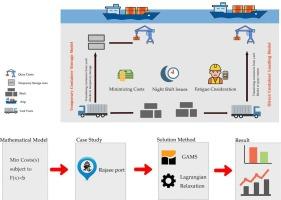Mathematical modelling of container loading in port with/without temporary container storage area: An HSE-based approach
IF 3.8
Q2 TRANSPORTATION
Transportation Research Interdisciplinary Perspectives
Pub Date : 2025-08-16
DOI:10.1016/j.trip.2025.101577
引用次数: 0
Abstract
Efficient container port operations rely on integrated processes including berth allocation, quay crane assignment, and yard truck planning. A significant challenge within these operations is managing the health, safety, and environmental (HSE) risks associated with workers’ fatigue, particularly during night shifts. Fatigue-related risks can lead to operational inefficiencies, increased accidents, and compromised safety outcomes, highlighting the need to address them within port optimization frameworks. This research presents two mathematical models to enhance container handling: the Temporary Containers Storage Model (TCSM) and the Direct Containers Loading Model (DCLM). In both models, the container yard is partitioned into blocks, with each block assigned to containers from a specific vessel. The berth is divided into positions where ships dock, and cranes are used to load containers onto the vessels. Effective resource management is essential to ensure that all containers are loaded before vessel departure. Analysis using the Lagrangian relaxation method at Shahid Rajaee Port reveals that workers experience 24 % more fatigue under the DCLM compared to the TCSM, despite the DCLM also leading to 22 % higher costs. These findings emphasize the critical importance of incorporating HSE considerations into container port operations, not only to improve safety and worker well-being but also to achieve long-term cost savings and enhanced productivity.

港口集装箱装载的数学模型(含/不含临时集装箱存储区):基于hse的方法
高效的集装箱港口运营依赖于包括泊位分配、码头起重机分配和堆场卡车规划在内的综合流程。在这些作业中,一个重大挑战是管理与工人疲劳相关的健康、安全和环境(HSE)风险,特别是在夜班期间。与疲劳相关的风险可能导致运营效率低下、事故增加和安全结果受损,因此需要在港口优化框架内解决这些问题。本文提出了两种提高集装箱装卸效率的数学模型:临时集装箱储存模型(TCSM)和直接集装箱装载模型(DCLM)。在这两种模型中,集装箱堆场被划分为块,每个块分配给来自特定船舶的集装箱。泊位被划分为船舶停靠的位置,起重机被用来将集装箱装载到船上。有效的资源管理对于确保所有集装箱在船舶离港前装船至关重要。在Shahid Rajaee港口使用拉格朗日松弛法进行的分析显示,与TCSM相比,DCLM下工人的疲劳程度增加了24%,尽管DCLM的成本也增加了22%。这些发现强调了将HSE因素纳入集装箱港口运营的重要性,不仅可以提高安全性和工人的福祉,还可以实现长期的成本节约和提高生产力。
本文章由计算机程序翻译,如有差异,请以英文原文为准。
求助全文
约1分钟内获得全文
求助全文
来源期刊

Transportation Research Interdisciplinary Perspectives
Engineering-Automotive Engineering
CiteScore
12.90
自引率
0.00%
发文量
185
审稿时长
22 weeks
 求助内容:
求助内容: 应助结果提醒方式:
应助结果提醒方式:


